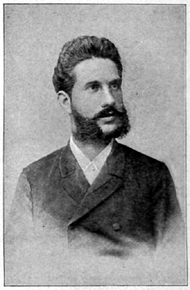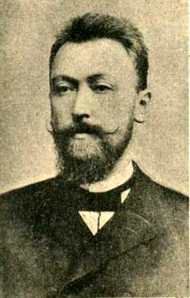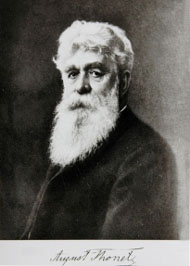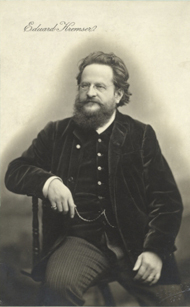
![Main heading: The Music of Gustav Mahler: A Catalogue of Manuscript and Printed Sources [rule] Paul Banks](../../images/General%20Heading3.jpg)
|
|
||||||||||||||||||||||||||||||||||||||||||||||||||||||||||||||||
|
|
||||||||||||||||||||||||||||||||||||||||||||||||||||||||||||||||
|
|
||||||||||||||||||||||||||||||||||||||||||||||||||||||||||||||||
|
|
||||||||||||||||||||||||||||||||||||||||||||||||||||||||||||||||
|
|
||||||||||||||||||||||||||||||||||||||||||||||||||||||||||||||||
|
|
||||||||||||||||||||||||||||||||||||||||||||||||||||||||||||||||
|
|
||||||||||||||||||||||||||||||||||||||||||||||||||||||||||||||||
|
|
|
|||||||||||||||||||||||||||||||||||||||||||||||||||||||||||||||
|
|
||||||||||||||||||||||||||||||||||||||||||||||||||||||||||||||||
|
|
||||||||||||||||||||||||||||||||||||||||||||||||||||||||||||||||
|
|
|
|||||||||||||||||||||||||||||||||||||||||||||||||||||||||||||||
|
|
||||||||||||||||||||||||||||||||||||||||||||||||||||||||||||||||
|
|
||||||||||||||||||||||||||||||||||||||||||||||||||||||||||||||||
|
|
||||||||||||||||||||||||||||||||||||||||||||||||||||||||||||||||
|
Index of Works |
|
|||||||||||||||||||||||||||||||||||||||||||||||||||||||||||||||
|
Site Map |
|
|||||||||||||||||||||||||||||||||||||||||||||||||||||||||||||||
|
|
||||||||||||||||||||||||||||||||||||||||||||||||||||||||||||||||
|
|
|
|||||||||||||||||||||||||||||||||||||||||||||||||||||||||||||||
|
|
||||||||||||||||||||||||||||||||||||||||||||||||||||||||||||||||
|
|
|
|||||||||||||||||||||||||||||||||||||||||||||||||||||||||||||||
|
|
|
|||||||||||||||||||||||||||||||||||||||||||||||||||||||||||||||
Josef Stritzko (1861–1908) c. 1889
Josef V. von Wöss (1863–1943) c. 1891
August Thonet (1829–1910)
Eduard Kremser (1838–1914)
|
||||||||||||||||||||||||||||||||||||||||||||||||||||||||||||||||
Josef Stritzko (1861–1908)
In the decade since c. 2005 it has become clear that the composer, conductor and businessman Josef Stritzko was a crucial figure in Viennese music publishing in the years 1888–1907. Since he has not been the subject of a biography based on contemporary documentation, the following account attempts to provisionally fill that gap. Thanks to the generous help of Dr Michael Lorenz in mining Viennese archives, and reference to contemporary published material (not all of it entirely reliable), a fairly detailed outline of his ultimately chequered career can be established. This revised biographical outline wholly supersedes the earlier account offered on this website.
Josef Franz Anton Stritzko was born in Vienna on 17 April 1861 in the the Innere Stadt, house number 464 (Seitensettengasse 5 in the new numbering). His father, Leopold Stritzko, was born in Obermarkersdorf in Lower Austria on 9 October 1823 and had married Maria Wilhelmine Kahn (c. 1822–5 November 1869) on 25 October 1851. Full details of their family have not yet been assembled, but a daughter, Leopoldine, was born on 7 August 1859, followed by Josef, who was baptised on 20 April 1861: his godfather was his uncle, Josef Stritzko (?–?1878), who in 1854 had started trading linen goods in Vienna. By c.1858 the premises were located at Hoher Markt 3 and the composer's father had joined the firm, becoming a (presumably junior) partner in Josef Stritzko & Co when it was established 27 December 1862. This management structure lasted a decade but in 1872 Leopold established his own linen shop at Hoher Markt 4, and his partnership with his brother was wound up.
After Leopold's departure Josef had been joined on 17 December 1872 by a new partner, Anton Stritzko,¹ who had been running his own shop nearby at Franz-Josefs Quai 35 for some years, and he assumed full control of the firm after Josef senior's death in c.1878. So far nothing has been uncovered that explains the changes within the firm, but it remained in Anton Stritzko's hands until early 1907. At about 17:30 on 1 March a shot was fired in the Stephansdom, and Anton was found, wounded, by a member of the Cathedral staff who took charge of his revolver. The wound, to his right hand, was not serious, and Stritzko explained that he had stopped at the Cathedral to hear prayers while taking his weapon to a gunsmith for repairs, and while there it had accidentally discharged: he vigorously denied that this had been a failed suicide attempt.² However on 6 March press reports that Jos. Stritzko & Co. was insolvent were widely published,³ and, after attempts to negotiate a rescue package failed, bankruptcy proceedings were commenced. At an early stage there were concerns for Anton Stritzko's mental health and by 9 March he had been committed to the psychiatric department of the Allgemeinen Krankenhaus after a second suicide attempt.⁴ The firm's collapse was widely attributed to a failure to modernise its fabrics, designs, marketing and management practices, though the role of money lenders was also mentioned.⁵ One result of the process was that the business was acquired by Josef Rummel's Nachfolger in early May 1907;⁶ the bankrupcy proceedings were eventually concluded on 26 August 1909.⁷
The earliest significant published source of information about Josef Stritzko junior is a short biography published by Gustav Kühle to coincide with the Vierte deutsche Sängerbundfest, held in Vienna in August 1890 (OMTZ, II/22 (15 August 1890), 5):
|
Josef Stritzko, born on 17 April 1861 should have become, according to the wishes of his parents, a shopkeeper or a civil servant. When his parents died he was 14 years old and already following his dearest wish by studying music, and eventually received the consent of his guardian – who had earlier studied music at the Leipzig Conservatoire [1] – to attend the Vienna Conservatoire. Thus, after graduating from the Handelsakademie he became a piano student of Professor Anton Door and a favourite composition student of Professor Franz Krenn, and in addition a very good leaving certificate Master Krenn gave him a personal reference in which he particularly emphasised his skill in instrumentation and his considerable knowledge and ability in harmony and counterpoint. In 1881 Josef Stritzko reported for military service as a bandsman and there avidly learnt the instrumentation of wind music. He played the Waldhorn and composed diligently and also undertook scoring for his band master. Returning from Cattaro and Innsbruck in 1882 he completed his studies at the Vienna Conservatoire as a military musician. His compositions are: 2 piano sonatas, 2 orchestral overtures, several string quartets, a piano quintet, 132 songs for voice and piano, of which 4 have been published by F. Röhrich in Vienna. He has written 34 choruses, of which the following have appeared: Das Fischermädchen from Rebay & Robitschek and Serbisches Ständchen. a particularly charming composition, from F. Röhrich in Vienna (which was brought out by us as the music supplement to issue II/7 of this periodical and which was performed by the Wiener Männergesangs-Verein conducted by Ed. Kremser on 2 July this year at a summer concert the Dreher-Park where it was received by the public with great aclaim, and was encored); also Sei uns gegrüsst by the Verlag des „Wiener Männerchores”, Zeiserlsang and Johannisnacht, which he published himself, and Das schönste Lied by Rebay & Robitschek in Vienna. In addition Rösleins Wiederkehr should be mentioned. At the moment the inspired composer is working on a setting of Frau Holde and a chorus Kahlenberger Wien by Schels. |
The works of Josef Stritzko belong to the noblest tradition and through their clarity and accessibility, and also their attractive melodies linked with wonderful harmonies, distinguish themselves as outstanding among the thousands of other works of the present. Vienna, his home town, may therefore look with particular pride on this darling of the muses, who seems to be called to bring much honour our glorious old city of the arts on the beautiful blue Danube. Josef Stritzko composes only what he from inner impulse must create, and thus his distinguished creations carry within themselves the guarantee of inner necessity and with their profound depths are able to penetrate to the heart of the listener, so that we finally can express no happier wish than: 'that yet more ingenious works by the inspired Josef Stritzko – just as deeply felt, just as full of melody, just as finely wrought, full of impressive originality as those already composed to our pleasure and his fame – may follow.' |
Essentially this narrative fits with other accounts – although his mother died of tuberculosis when he was only eight – and it usefully refers to a number of works (and genres) that do not figure on other contemporary lists of his output. Another, rather more detailed, biography appeared three years later (DKMZ 20/3 (1 February 1893), 33 [click on the date to view the original article]):
|
Josef Stritzko, a representative of the younger school of Viennese musicians, first saw the light of day on 17 April 1861, the son of the then proprietor [actually a partner] of the firm Josef Stritzko & Co., sellers of linen goods on Hoher Markt in Vienna, and according to the wishes of his parents, was to follow the example of his father and devote himself to position of merchant, and to this end enjoyed an exceptional education. However, from his earliest youth the inclination towards noble Music was aroused in him and already as a child of six years he provided evidence of a talent that could not be denied or overlooked, when, without having received training, he taught himself to pick out on the piano the melody and accompaniments of the songs that at that time he most frequently heard or sang, and played them as quickly as possible. His first steps on a musical career were guided by Frau Elise Schwarzmann, who introduced him to the mysteries of piano playing and who even now he highly esteems as a teacher, and whose painstaking cultivation of his youthful talent he still acknowledges with words of grateful thanks.
Until his fifteenth year he was in the care
of this teacher; then his father died and as he left no
fortune, our young artist, who did not wish to chain himself
to a business career, gave piano lessons himself in order to
be able to continue his musical studies. Supported by his
guardian, who recognised and appreciated his talent, he
attended the Conservatoire, where he studied piano with
Professor Anton Door up to the second advanced level, and
harmony with Mr Wilhelm Kleinecke jun. Following excellent
passes in the examinations in these subjects, he devoted
himself to composition with Professor Krenn, whose favorite
pupil he was, and from whom he received, alongside the
Conservatoire Certificate, a second in which Professor Krenn
praised his special skill as an orchestrator and recommended
him as an orchestral conductor.
In 1880 he took over the Wiener Männerchor,
which, at that time made up mainly of inhabitants of the
Landstrasse suburb, called itself Landstraße Sängerclub; but
he could enjoy the leadership of this association barely a
year before he was called up for military service, which he
fulfilled with the band of the 4th Infantry Regiment 'Hoch-
und Deutschmeister' first in Cattaro [then in Dalmatia; now
Kotor in Montenegro], then from 1882 in Innsbruck. There he
found the opportunity, through orchestration and some prompt
composition, to make himself prominent and well-known. The
band played his compositions often and with pleasure; apart
from appearing in the orchestra, where he played the
Waldhorn, he also often appeared in concerts as a soloist
and even today his musical performances are spoken of in
Innsbruck. In 1883 he returned to Vienna with the band,
where he continued his studies. In 1884 he was free of the
military and he thought of establishing a home, a home of
his own, to which end might take a wife; he therefore
combined his two skills, those of music and business
studies, and entered the music engraving establishment of J.
Eberle & Co., in which prominent firm he now presides as the
head of the music department. |
Despite the almost wearying commercial activity Stritzko still finds time and leisure, to give expression to his musical inclinations and finds relaxation in choral conducting. Since 1884 [recte 1886] he has again stood at the head of the Wiener Männerchor, a small, but loyal and energetic group of keen singers which he has led from victory to victory in the field of male-voice singing. Of his compositions for male voices, for which our valued colleague, the eminent poet A. Schels, has provided most of the texts, one might mention the most outstanding: Das schöne Lied, Kahlenbergerwein and his newest, Landsknechts Tod. However the smaller, very idiomatic and tuneful and also characteristic choruses such as Serbisches Ständchen, Ein Liebeslied aus Wien and the widely sung Kling, klang, Gloria, have been introduced to our elite societies and made famous far and wide. As a conductor Stritzko is indisputably one of our best, not just with respect to the public, but also, especially thanks to his training, the inspiration and firing up of choir or orchestra; and from his serious and tireless aspiration and effort laurels should blossom for him, most luxuriantly we hope, in both fields. We must also mention that Stritzko participated at the IV. Deutsche Sängerbundfest [1890], and also, with a Liedertafel aus dem Eigenen – at which text and music of all the programme items heard were supplied by the association's members – he stood out significantly, so that, alongside the honorary membership of his own association previously awarded for his efforts, he was awarded that of the Akademischen Gesangvereins zu St. Pauli in Leipzig. Hail to him! |
This article – which was clearly written with Strizko's cooperation, if not active encouragement – was accompanied by a short song, Das Veilchen, to a text by Vincenz Zusner, printed (as were all the periodical's music supplements at this time) by Jos. Eberle & Co. It is possible that the work dates from Stritzko's student years, as the Zusner prize – for settings of the poet's rather pallid verse – was an annual award at the Vienna Conservatoire offering a cash prize that attracted a number of budding but impoverished composers (including Mahler) who might not otherwise have looked at Zusner's poetry. The decision to feature the composer in this way may not have been disinterested: by this date the periodical had been taken over by the firm of Rebay & Robitschek, one of the publishers of Stritzko's music.
The articles quoted above probably formed the basis of entry in an Austrian dictionary that appeared in 1902 (KDOK, 587), but it was supplemented with some additional information about Stritzko's career as a composer:
|
Stritzko, Josef., VII Seidengasse 3, geb. Wien, 17 April 1861, erhielt den ersten Clavierunterricht von Elise Schwarzmann, wurde dann von Professor Anton Door ausgebildet; studierte beim Wilhelm Kleinecke Harmonie und Contrapunkt, legte hierüber am Wiener Konservatorium die Prüfung ab und studierte dortselbst bei Prof. Krenn 1880–1882 Composition. S. componierte bis jetzte 64 Lieder, 52 Männerchöre, das Tongemälde für Männerchör, Soli und Orchester <Der Landsknecht>, die Operette <Hochzeit auf Sacramento> (text von B. Buchbinder), das Musik-Lustspiel <Der Hofmeister> (Text von O. Fronz) und ein musikalisches Bilderbuch für Kinder. |
Stritzko, Josef, VII Seidengasse 3., b. Vienna, 17 April 1861, received his first piano lessons from Elise Schwarzmann, was later trained by Professor Anton Door; studied harmony and counterpoint with Wilhelm Kleinecke, sat the Conservatoire examination in that subject and studied composition there with Prof. Franz Krenn in 1880–2. To date S. has composed 64 Lieder, 52 male-voice choruses, the tone picture The Mercenary for men's voices, soloists and orchestra, the operetta Marriage in Sacramento (libretto by B. Buchbinder), the musical comedy The Tutor (libretto by O. Fronz) and a musical picture-book for children. |
Stritzko at the Vienna Conservatoire
The documentation of Stritzko's studies at the Conservatorium für Musik und darstellende Kunst is contained in his Matrikel (matriculation registration form) which does not wholly corroborate the published biographies.⁸ It does confirm that his study was interrupted by military service: he entered on 15 September 1880, but was absent for the academic year 1881/2, re-entering on 1. October 1882. There appear to have been some unusual features to his studies: he initially registered for composition with Franz Krenn as his principal subject but quickly transferred to the second year of the advanced piano course (Ausbildungsschule) taught by Anton Door, with the first year of the composition course with Krenn as a frei Nebenfach (elective subsidiary course) and Chorschule and Chorübung as obligatory subsidiaries. Despite his transfer to composition as a subsidiary course, the Director, Josef Hellmesberger sen., agreed that Stritzko should be examined in composition as his principle course. The motivations behind these academic manoeuvres are unexplained, but at the end of his first year Stritzko achieved grade 2 (= satisfactory) in the composition examination; no grade for his studies with Door is recorded. The two choral courses which he attended must have been particularly useful, as it was in 1880, with the Landstraße Sängerclub, that he began his career as a choral conductor.
When Stritzko rejoined the Conservatoire in 1882 he registered for the second year of the composition course with Krenn, but there is no record of his signing up for any subsidiary courses, of his end-of-year examination result in composition, or of his receiving a leaving certificate; these gaps may reflect either poor performance or poor record keeping. Nevertheless it is notable that there is also no evidence in his Matrikel that Stritzko studied Harmony with Wilhelm Kleinecke while a student at the Conservatoire, or that he studied with Bruckner while there – as claimed by August Göllerich (see below) – though it is possible that such lessons were arranged privately. All in all, this does not appear to have been a particularly distinguished studentship, but he clearly had facility as a pianist and in later years occasionally appeared as an accompanist at events organised by the Wiener Männerchor. On at least two evenings he rounded off the event with keyboard improvisations, on the second occasion (16 April 1887) in partnership with Anton Stritzko at a second piano.⁹
Military Service
For Stritzko, his time in the Army was probably a useful, practice-based phase of his musical training: the Hoch- und Deutschmeister Kapelle in which he served, was one of the best known and most admired in the Austrian army, and over the years included a number of musicians – such as Joseph Helmesberger, Joseph Bayer, Robert Stolz, Edmund Eysler und Carl Michael Ziehrer – who went on to have major careers. Since 1918 it has been a private organisation and it seeks to maintain the old tradition of Austrian military music.¹⁰
The regiment arrived in Innsbruck from Cattaro on 17 November, 1881 and left for Vienna on 15 September 1882 (IN 28/238 (12 November 1881), 3830; ibid. 29/211 (15 September 1882), 3535). The Kapellmeister at the time was Anton Klemm (1844–1920), and he conducted the band's first concert in Innsbruck, at Kraft's Veranda, on 11 December with some notable success (IN, 28/279 (7 December 1881), 4181–2):
|
(The Deutschmeister Orchestra) – Last Sunday evening the orchestra of the Infantry Regiment No. 4, Hoch- und Deutschmeister, under the personal leadership of Kapellmeister Mr Anton Klemm, performed for the first time at Kraft's Veranda. The conductor had the apt idea of opening the concert evening with a musical greeting to Innsbruck of his own composition, which was received with general and the most lively success. It is a march full of melody and spirit entitled 'nach Innsbruck', for which general success can certainly be predicted. The Band played brilliantly and delighted the public that filled the room to overflowing. Vigorous applause followed every number, many of which had to be repeated. The Band will play every Sunday at Kraft's Veranda; thus the music-loving public have richly enjoyable evenings in prospect. |
Fig. 1 Innsbrucker Nachrichten, 17 December 1881 Advertisement for the second Innsbruck performance by the Hoch- und Deutschmeister Regimental Band |
As the report and advertisement make clear, the band could call on string players for concerts. Of the works composed while Stritzko served with the Kapelle, the titles of three marches have been recorded: Kaiser Jubiläums-Marsch (though one might wonder exactly when this was composed), Landsturm Ade! (published by Rebay & Robitschek in 1887) and Oberst Möraus-Marche (composed in honour of the commanding officer of the regiment) (see ASRM, 306 and BMPP, 326). Stritzko's connection with the band did not end with the completion of his military service: on at least two occasions (1886, 1893) it took part in events organised by his choir.
Stritzko and the Wiener Männerchor (1880–96)
The Wiener Männerchor was a small association founded in 1881: its membership seems to have been only around thirty, and published reports of its performances often make the point that this was unusual.¹¹ That in 1880, at the age of nineteen, Stritzko took over the choir's forerunner, the Landstrasse Sängerclub (see above), seems remarkable, but he was apparently assiduous in his participation in choir rehearsals and classes at the Conservatoire, and evidently developed into a very able choir trainer and conductor over the years. Following his military service it was not until the start of the 1886–7 season that Stritzko assumed a role in the artistic leadership of the new society, as joint Chormeister, working alongside Josef Pobisch. This arrangement was soon abandoned, and by January 1887 Stritzko was in sole charge: during the next ten years he gradually established a distinguished reputation for himself and the choir. At the outset reviewers occasionally noted problems of balance within the small ensemble, poor diction and ensemble, and under-rehearsal, but Stritzko not only addressed these issues – in 1893 the choir was described as a 'small but exceptionally tight vocal ensemble' – but also introduced more nuanced dynamics and phrasing.
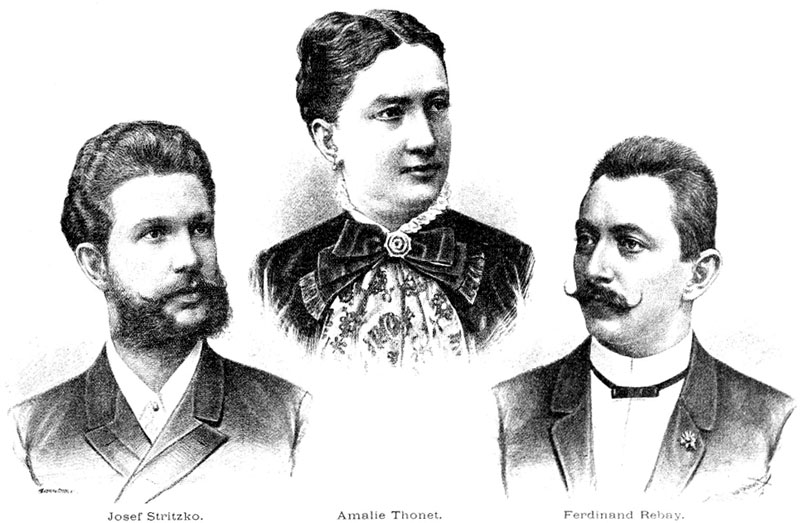
Fig. 2
Österreichische Musik- und Theaterzeitung II/24 (15 September 1889), 7
It was presumably not coincidental that during Stritzko's tenure two new members were recruited from within the music business: the talented and popular amateur baritone and after-dinner speaker Ferdinand Rebay, who had a career as a music seller and publisher (including a brief period on the staff of J. Eberle & Co.), and Josef V. von Wöß (1863–1943), composer, teacher, conductor, and editor first at J. Eberle & Co. and later Universal Edition, who became the much-admired accompanist of the choir. Between them Stritzko and von Wöß also provided a substantial part of the repertoire, which fitted in with a programming policy that promoted new works alongside classics for the medium, and also sometimes dispensed with the normal trappings of guest instrumental solos and post-performance dancing. The seriousness of approach and accomplishment of the performers was noted (see Die Lyra XII/6 (15 December 1888), 50) as was the decision to give a concert entirely of new works (13 December 1891) and one solely of music composed by members of the association (2 April 1892): Josef Stritzko, Jos. V. v. Wöss, August Thonet (1829–1910, the retired head of the famous Thonet firm of furniture manufacturers and amateur composer, whose family supported the choir financially), Max von Weinzierl (1841–98, honorary member), Jacob Thonet (August's brother), Franz Tittrich and Eduard Kremser (honorary member). Although Stritzko briefly also conducted the Wiener Männergesangverein „Arion” in 1889 his tenure of the post of Chorleiter of the Wiener Männerchor apparently continued until the end of the 1895–6 season. In the 1898–99 season he conducted the Wiener Sängerbund and he was a Ausübende (performing) member of the Wiener Männergesang-Verein (KAWM, 452).
Josef Eberle & Co.
According to the article in the Deutsche Kunst und Musik Zeitung Stritzko decided in 1884 that with his military service and musical training complete, it was time to settle down; on 15 November 1885 he married Franziska Bauer (16 August 1862–January 1944) and at about the same time found a role that drew on both his commercial and musical training, working for the printing firm owned by his brother-in-law, Josef Eberle, where he was soon appointed director of the printing department. (LEH (1886), 990).
The scope of Stritzko's duties and responsibilities during his early years with Jos. Eberle & Co. is not entirely clear. At present there is no evidence that he had any previous training in music printing or lithography, but by 1900 had developed sufficient technical and historical knowledge to be invited to give two lectures to the Vienna branch of the International Musical Association, 'Über moderne Notendruck und -Stiche' (26 February) and 'Über die Entwicklung des Notenstiche und -Drucke' (5 March) (ZIMG I (1899–1900), 257; 363; both were chaired by Guido Adler).¹² There is also some evidence that he undertook in-house editing and correction of music (ASBD, 3/9, 216). Stritzko joined the firm shortly before preliminary planning for Eberle's first foray into music publishing, the Wiener Volksausgabe (1888–9), must have begun, and he eventually contributed an edition of Schubert songs – 'revised from the the oldest editions' – to the project. At about the same time he was involved in the firm's other publishing venture, the bi-monthly periodical An der schönen blauen Donau which Eberle acquired in 1888: in the following year Stritzko served briefly as managing editor (verantwortlicher Redacteur) of five issues. Whether Stritzko played any role in the initiation of these projects is unclear, but after the Volksausgabe came to an end in 1889 and the magazine was sold, Stritzko was closely involved with a new phase in Jos. Eberle & Co.'s publishing ventures, the publication of Bruckner's music.
|
Nach den großen Erfolgen der letzten Jahre war Bruckners Ansehen als Komponist auch in Wien so gefestigt, daß sich eine heimische Firma, die graphische Anstalt Josef Eberle u. Co. (die später auf die Universal-Edition A.G. überging) zur Drucklegung der noch ungedruckten Werke des Meisters bereit erklärte. Die Verhandlungen mit dem Verleger Josef Eberle führte dessen Verlags-Direktor und Schwiegersohn Josef Stritzko, der seinerzeit Bruckners Schüler am Konservatorium gewesen war und sich später als Komponist von Operetten und Chören einen Namen gemacht hat. Zuerst sollten Großindustrielle zur Bereitstellung der Druckkosten gewonnen werden, doch zogen sich alle wieder zurück. So entschloß sich Eberle, die Werke auf eigene Kosten – sie beliefen sich auf 36.000 Gulden – zu drucken. Als Stritzko es dem Meister mitteilte, war dieser selig... Zunächst hatte Bruckner die Absicht, die erste, der Universität gewidmete Symphonie drucken zu lassen. Er holte von der genannten Firma einen Voranschlag (vom 1. Juli) ein, in welchem 100 Partituren mit 693.55 Gulden, das 100fache Stimmen-material mit 717.12 Gulden, zusammen 1410.67 Gulden geboten wurden. Im weiteren Verlauf der Verhandlungen kam es dann am 14. Juli zu folgendem Vertrag... |
After the great success of recent years Bruckner's reputation as a composer, even in Vienna, was so secure, that a local company, the printing establishment Josef Eberle & Co. (which later turned into Universal Edition A.G. [not quite correct – the Erster Wiener Zeitungs-Gesellschaft which, from 1894 owned the firm, was one of the investors and shareholders in UE) announced its interest in printing the Master's as yet unpublished works. The negotiations with the publisher Josef Eberle were led by the latter's Director of Publication and son-in-law [recte: brother-in-law], Josef Stritzko, who had been a student of Bruckner at the Conservatoire and who subsequently made a name for himself as a composer of operettas and choruses. At the outset major industrialists were to be persuaded to cover the printing costs, but they all withdrew. So Eberle resolved to print the works at his own cost – which amounted to 36,000 Gulden. When Stritzko reported this to the Master, he was overjoyed.... Initially Bruckner had the intention of having the First Symphony, dedicated to the University, printed. He received an estimate (dated 1 July) from the firm, in which 100 scores were costed at 693.55 Gulden and 100 part sets at 1410.67 Gulden. After further progress in the negotiations the following contract resulted on 14 July... |
The contract with Jos. Eberle & Co, signed on 14 July 1892, was generous, providing the composer with a modest but guaranteed income from his works for the rest of his life, and resulted in the distribution of a number of works by Doblinger, including the First Symphony (1893), Second Symphony (1892), Fifth Symphony (ed. Schalk, 1896), Sixth Symphony (1899), Ninth Symphony (1903), Mass in E minor (1896) and Mass in F minor (1894).
Compositions
From the earliest biographical article quoted above it seems that as a student Stritzko tackled some of the genres of ernster Musik (serious music), composing piano sonatas, overtures and chamber music, but he seems not to have returned to these in later years. His time on military service may well have convinced him that his true gifts lay in more popular repertoires, and having tried his hand at band music, he seems to have found a more secure niche in the male-voice choir community, helped by his undoubted gifts as a choir-trainer: as the partial work list indicates it was was in this medium that he produced a substantial body of work, and most readily found publishers. The dedications also reflect the tight-knit community within which he worked for more than a decade.
At first glance it would seem that Stritzko's productivity declined after the late 1890s but this impression in part reflects his decision to focus on works for the stage. In any case his business commitments and responsibilities were increasing, reducing the time he could have devoted to creative work. Of his first venture into music theatre, an operetta, Hochzeit auf Sacramento, nothing is known: it was presumably composed sometime between 1893 and c.1900, but was not published or performed. It was followed in 1901 by a 'Musik-Lustspiel', Der Hofmeister, to a libretto by Oscar Fronz (1861–1925), who had recently had a success at the Jubiläumstheater with Familielumpen. That Stritzko was able to secure performances at the Theater an der Wien almost certainly reflects his business contacts with two of the owners, Leon Doret and Josef Simon: both were on the board of Universal-Edition as private shareholders and would therefore have met Stritzko as the managing director of the Erster Wiener Zeitungs-Gesellschaft, a corporate shareholder and the firm's music printer.
The show opened on 11 March 1901, conducted by the composer, and had seven performances in all. The music – especially the instrumentation – garnered praise from the critic of the Deutsches Volksblatt (signed 'Sch—r') who nevertheless noted that despite the enthusiastic reception from family and friends of the composer it would be the second night which would reveal whether the work had enough quality to survive on the Viennese stage: it did not. So the fact that at least three numbers from the work were published by Doblinger, may have also have been influenced in part by Stritzko's role as the printer of that firm's publications.
The Lustspiel's successor, Tip-Top, was doubly cursed: completed in 1905 and apparently accepted for performance at the Theater an der Wien, it was preceded by the first night of Die Lustige Witwe by Lehar, which went on to run solidly for 450 performances, thus postponing Stritzko's premiere until 5 October 1907, when, according to the same Deutsches Volksblatt critic, it was apparent that Stritzko's 'attractive and charming music' was hampered by a 'completely worthless and very badly made libretto'. The new work ran for only 25 performances in total, but the postcards advertising the work announce the availability of recordings on the Odeon label; the vocal score and a number of spin-off items based on the operetta were published by W. Karczag and C. Wallner and printed, appropriately (and handsomely), by Jos. Eberle & Co. (EWZG). The score reveals a genuine, if scarcely original talent, and the relatively detailed indications of scoring lend credence to the positive comments about Stritzko's gifts as an orchestrator; in 'Dolly's Traumlied (Die Brautnacht)' (Act II), Stritzko briefly moves beyond wholly predictable structures to something more ambitious, a charming and explicitly erotic lyric scena.
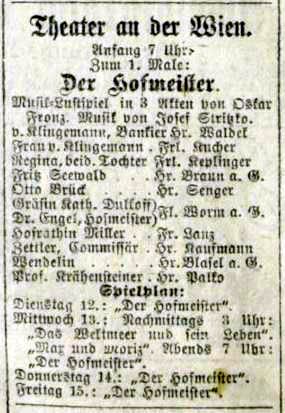 |
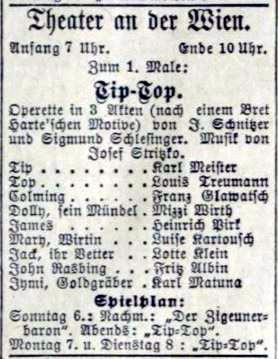 |
|
Fig. 3 Deutsches Volksblatt 4377 (11 March 1901), 8. Apart from those listed, there were two further performances on 16 and 17 March. |
Fig. 4 Deutsches Volksblatt 6738 (5 October 1907), 15. The operetta ran for 25 consecutive performances up to 29 October. |
A new phase in Stritzko's business career opened up when in late 1894 his brother-in-law agreed to sell his firm to the Erste Wiener Zeitungs-Gesellschaft, and especially after board-room manoeuvring in the parent company led to Eberle's resignation early in 1898. For whatever reason, Stritzko chose not to join him in setting up a new printing business, but remained where he was. One can only suppose that this was a difficult time for the two families, but Stritzko gained some rewards, as one of the three executive directors with places on the EWZG board, and by c. 1902 he was the only such director, having been an authorised signatory for the firm since about 1898. It was probably Stritzko who was chiefly responsible for the negotiations with Guido Adler and Mahler that culminated in a publishing contract that initially covered the scores, parts and piano arrangements for Mahler's first three Symphonies, though it was apparently extended subsequently to cover the Wunderhorn songs, Das klagende Lied and the Fourth Symphony.
Josef Eberle's departure from the Erste Wiener Zeitungs-Gesellschaft in early 1898 coincided with a series of business decisions, all of which must have involved Stritzko in his position as a director of the firm, and probably impacted on the time he had for composition.¹³ In 1898 EWZG acquired a new property at Seidengasse 9, which permitted the building of a new wing to the printing works, designed by Karl Stigler (1865–1926), that considerably expanded the firm's printing capacity, though at the cost of two years of operational disruption. Other decisions proved less immediately advantageous, including the sale of the Illustriertes Wiener Extrablatt in 1905. The resulting loss was considerable and in that year the company recorded an annual trading deficit (of 1,197,806 Kr.) for the first time in its history, shareholders lost 25% of their investment at a stroke and no dividend was paid. Although the restructured company managed to achieve a small profit and paid a modest dividend in 1906, serious management failings emerged the following year and the annual report recorded that 'notable damage resulted from the irregularities of the previous director, which necessitated substantial right-offs'.
The director concerned was Stritzko and although by 1907 he had an apparently enviable position – a family home at Andreasgasse 17 provided by the firm, and an annual salary reported to be K. 20,000¹⁴ – it proved to be a singularly unhappy year. In the spring he witnessed the insolvency (and subsequent bankruptcy) of Josef Stritzko & Co. and the institutionalisation of Anton Stritzko, an emotionally unsettling situation which may have had financial consequences for Josef, and this was followed by the commercial failure of Tip-Top. It was reported that Stritzko had pinned great hope on the success of the work, and towards the end of the run was conducting many of the performances, perhaps in a desperate attempt to establish it in the repertoire, but in the event lost about K 30,000 on the venture. The impact of those developments on his health was deleterious and he applied for and was granted sick leave. It was while he was recuperating in the Tirol that an internal audit was initiated and revealed irregularities in the book-keeping: the press reports indicate mismanagement rather than dishonesty was deemed to be the cause, so it is perhaps significant that Mahler noted as early as 1903 that the firm had not been sending him annual royalty statements as stipulated by his contract (GMBaA, 164–5; GMBaA, 131). The upshot was that Stritzko resigned or was dismissed in February 1908, together with two other senior members of staff; perhaps not coincidentally four non-executive members of the board resigned the same year. In all K. 166,673 had to be written off, contributing to a trading deficit of K. 9,242 in 1907.
Stritzko scarcely had time to recover from this
professional disaster as he died unexpectedly a month later at the age of 47, as reported
in the
Neue freie Presse (15643 (Nachmittagsblatt, 9 March 1908), 6):
[†Komponist Stritzko.] Gerstern um 5 Uhr nachmittags ist in seiner Wohnung, Andreasgasse, im 7 Bezirk,
der bekannte Komponist Josef Stritzko eines plötzlichen Todes
gestorben. Er war seit etwa drei Monaten leidend, hatte sich
jedoch scheinbar erholt und war wieder ganz rüstig. Gestern
hatte er sich dreieinhalb Stunden außer Hause befunden.
Heimgekehrt, wurde er von Brechen befallen. Bald darauf trat ein
Bluterguß ein, und trotz ärztlicher Hilfe verschied Stritzko um
5 Uhr nachmittags. Er hat als Komponist von Männerchören und
verschiebenen [sic] Operetten schöne Erfolge erzielt. Er war
auch bei der Kunstanstalt Josef Eberle in leitender Stellung und
trat dann in die Druckerei= und Verlagsaktiengesellschaft
vormals Ritter v. Waldheim. & Eberle, bei der er Vizedirektor
und schließlich erster Direktor wurde. Erst kürzlich trat er von
diesem Posten zurück.
...Yesterday at five o'clock in the
afternoon, the well-known composer Josef Stritzko died
suddenly at his home in Andreasgasse, in the 7th District.
He had been ill for about three months, but had apparently
improved and was again very hale and hearty. Yesterday he
spent three and a half hours out-of-doors. Returning home he
was seized by vomiting. Soon afterwards haemorrhaging began
and despite medical help Stritzko departed at 5 o'clock in
the afternoon. As a composer of male-voice choruses and
various operettas he had achieved fine success. He also had
a leading role in the art printers Josef Eberle and later
moved to the printing and publishing company formerly Ritter
v. Waldheim & Eberle, where he was deputy director and
finally director. He recently resigned from that post.
Wiener Abendpost, (9 March 1908, 2–3)
:|
(Josef Stritzko†.) Gestern Abend ist in seiner Wohnung im 7. Bezirk, Andreasgasse, der Komponist Josef Stritzko plötzlich gestorben. Er stand im 47. Lebensjahre. Stritzko hat Männerchore, Lieder, das Tongemälde „Der Landsknecht”, das Musiklustspiel „Der Hofmeister”, ein musikalisches Bilderbuch für Kinder und die Operette „Tip-Top” komponiert. Er war zuletzt Direktor der Druckerei= und Verlags=Aktien=Gesellschaft vormals R. von Walheim u. Eberle. Erst kürzlich trat er von diesem Posten zurück. |
... Yesterday afternoon the composer Josef Stritzko died suddenly at his home in Andreasgasse, 7th District. He was in his 47th year. Stritzko composed male-voice choruses, Lieder, the tone picture The Mercenaryy, the operetta Marriage in Sacramento, the musical comedy The Tutor, a musical picture-book for children and the operetta Tip-Top. He was additionally director of the printing and publishing joint stock company formerly R. von Waldheim and Eberle. He recently resigned from that post. |
OBDZ,
36/11 (12
March 1908), 138):
Josef Stritzko†. Am 8. d. M. verschied plötzlich
der kürzlich von seiner Stellung enthobene Direktor der Drucherei- und
Verlags-Aktinegesellschaft R.v. Waldheim—Jos. Eberle & Co., Josef
Stritzko, in 47 Lebensjahre. Er hatte gediegenen musikalischen
Unterricht genossen und später eine Reihe von Kompositionen geschaffen
darunter Chöre, Operetten, ein Musiklustspiel. Seinen Kompositionen
verlegte er selbst. Er mußte aus seiner Stelle scheiden, weil sich
infolge Unregelmäßigkeiten in der Buchführung ein Schaden von 150.000 K.
für das Unternehmen ergeben hatte.
Josef Stritzko. On 8th of this month,
Josef Stritzko, the recently dismissed director of the Printing
and Publishing Company R.v. Waldheim—Jos. Eberle & Co., died
suddenly in his 47th year. He had enjoyed a sound musical
education and later created a series of compositions, including
choral works, operettas, a musical comedy. He published his
compositions himself. He had to leave his post because a loss of
150,000 K. for the business result resulting from
irregularities in the bookkeeping, had come to light.
It is striking that none of these obituaries do more than report his senior role in Waldheim-Eberle, making no reference to his achievements there, but focus instead on his activity as a composer. The Österreichisch-Ungarische Buchdrucker-Zeitung is unusual in asserting that Stritzko published his own music – which was not wholly true, and was probably intended as disparagement – before moving on to the information about his recent dismissal. Whether the reader was intended to draw any conclusions from that juxtaposition of statements in the final sentence is moot, but Stritzko's culpability in the firm's losses is strongly implied.
Stritzko was buried in the Zentralfriedhof (53A, 10, 16) on 10 March: his early death left Franziska (she apparently preferred the abbreviation Fanni) with four children to bring up: Hermann (28 August 1885–?), Richard Anton Josef (29 February 1888–May 1910), Marie (7 August 1889–February 1976); and Margareta (Grete) (6 August 1894–October 1975), who inherited her father's musical gifts, and studied piano at the Akademie für Musik und darstellende Kunst, 1909–13, supported by a Stiftungsplatz provided by the Wiener Männergesangsverein. She was living with her mother at the time (in Wien XIII/6) and her guardian was a former business colleague of her father, Josef Anton Knoblach of Knoblach & Moeßmer, a business agency that represented Waldheim-Eberle.¹⁵
The early report about the move to replace Stritzko on the board of the firm, published in the Neues Wiener Journal (18 February 1908, 9), pointedly drew attention to the timing of the crucial audit – hinting that he was the victim of board-room manoeuvring – and offered a sympathetic and by no means inappropriate assessment of his significance, arguing that within Viennese musical life he had played, if not a leading role, a significant one. His works for male voices were not quickly forgotten (surviving in the repertoire at least as far as the late 1920s), and on 23 May 1909 a monument to his memory, funded by members of the Wiener Männerchor in memory of their late honorary conductor, was inaugurated in the Zentralfriedhof.
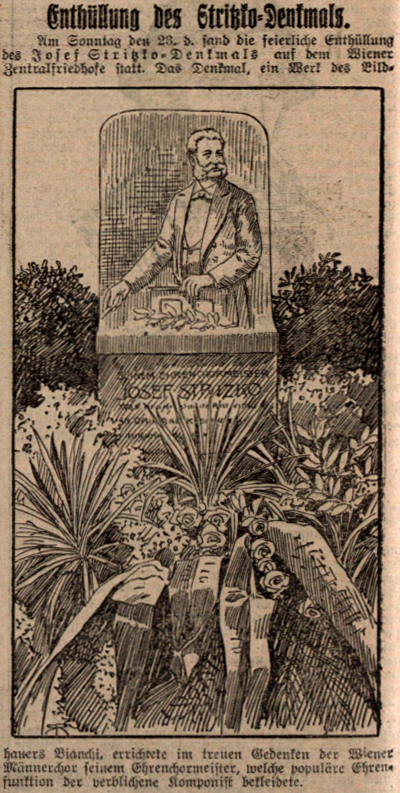
Fig. 5
Illustrierte Kronung-Zeitung, 27 May 1909, 6

![]() https://orcid.org/0000-0002-2258-0267
©
2007-21 Paul Banks | This page was lasted edited on
07 January 2021
https://orcid.org/0000-0002-2258-0267
©
2007-21 Paul Banks | This page was lasted edited on
07 January 2021
